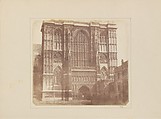Westminster Abbey
Nicolaas Henneman Dutch
Not on view
Talbot's negative-positive photographic process, first made public in 1839, would change the dissemination of knowledge as had no other invention since movable type. To demonstrate the paper photograph's potential for widespread distribution--its chief advantage over the contemporaneous French daguerreotype--Talbot produced The Pencil of Nature, the first commercially published book illustrated with photographs. With extraordinary prescience, Talbot's images and brief texts proposed a wide array of applications for the medium, including portraiture, reproduction of paintings, sculptures, and manuscripts, travel views, visual inventories, scientific records, and essays in art.
Despite the revolutionary nature of Talbot's undertaking, or perhaps because of it, The Pencil of Nature was not a commercial success. Today fewer than forty substantially complete copies--many quite faded--are extant. The present example, containing all twenty-four plates and still in its rare original fascicle covers, was formerly in the collection of Talbot's daughter Matilda.
Due to rights restrictions, this image cannot be enlarged, viewed at full screen, or downloaded.

